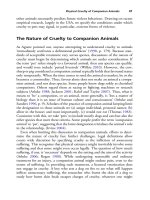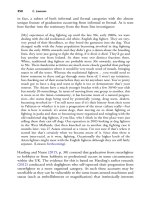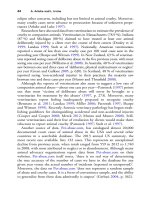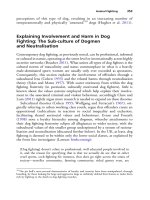The palgrave international handbook of a 174
Bạn đang xem bản rút gọn của tài liệu. Xem và tải ngay bản đầy đủ của tài liệu tại đây (25.54 KB, 1 trang )
166
E. Cudworth
Animals in less intensive systems still have radically foreshortened and
difficult lives. Beef cattle in Britain are fattened quickly and slaughtered
below 18 months; dairy cattle are usually slaughtered by 6 or 7 years of age
when their productivity reduces and endure a life fraught with mastitis and
lameness. The calves they must produce will be kept or sold for dairy
production, sold for veal or beef production or often, simply shot
(Stevenson 1993). Most beef and dairy cattle are reared on a ‘free range’
system, but some farmers are turning to semi-intensive housing and keep
cattle inside over winter. Although there are battery lamb farms in Britain,
most sheep live outside. This creates different problems, with estimates
between three and four million lambs dying each year from cold or starvation
(Gellatley 1994, p. 79). Most are five months old when slaughtered,
although breeding females may be kept for up to five years, significantly
less than their potential 12 or 14 year lifespan. There are, undoubtedly,
examples of good practice, yet contemporary animal farming in a country
such as the UK is overwhelmingly large scale and for some species (birds,
pigs) operates predominantly on a warehouse model where disengagement
rather than positive interaction with animals is a key feature of the organisation of labour. Jonathan Safran Foer’s (2009) investigation of farming
practices in the USA leads him to conclude that it is very difficult for
small-scale producers to survive, or for animals to be raised with high welfare
standards, such is the pressure towards intensive production and mechanisation that less than 1 % of farmed animals in the USA are raised outside an
intensive and mechanised system.
There are other kinds of farming and farmed animal that have not been
included here such as rabbits and deer, both growth areas in farming in
Europe and in the case of rabbits, highly intensive in terms of production.
Another important growth area has been the farming of fishes. Whereas in
1980 the proportion of intensively farmed ‘fish’ was negligible in terms of
market share, it now constitutes 50 % of the market, and with depleting fish
stokes, will likely expand. Like other intensive systems, fish in aquaculture
have highly restricted mobility, are unable their ability to perform speciesspecific behaviours, and are subject to parasitic infestation and disease
(CIWF 2009c).
My own research into the breeding and rearing of farmed animals has been
particularly concerned with the ways forms of gender-based violence can be
evidenced in terms of the treatment of chickens, pigs, sheep and cattle. In the
egg industry, for example, laying hens, particularly in intensive conditions,
are worth so little that any problems associated with laying (such as prolapsing of the uterus) are ignored and hens are simply left to die painfully and









